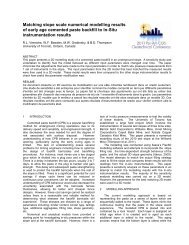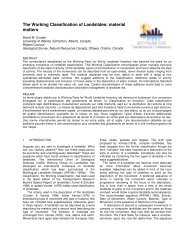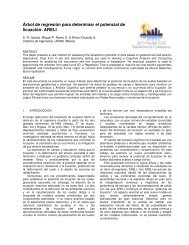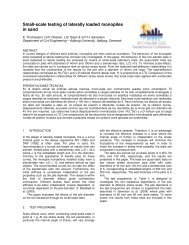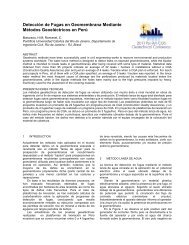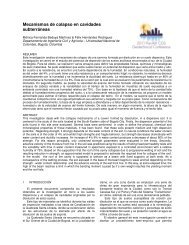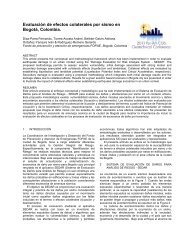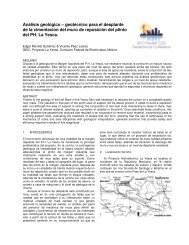MS Word Technical Paper Template
MS Word Technical Paper Template
MS Word Technical Paper Template
Create successful ePaper yourself
Turn your PDF publications into a flip-book with our unique Google optimized e-Paper software.
Field retention tests to evaluate nickel retention on<br />
mine waste rock<br />
Isabelle Demers, Bruno Bussière & Benoît Plante<br />
Université du Québec en Abitibi-Témiscamingue, Rouyn-Noranda, Québec,<br />
Canada<br />
ABSTRACT<br />
A field retention test campaign was designed to verify the retention of nickel two field cells, one with “fresh” waste rock<br />
and one with “weathered” waste rock. They were watered with nickel-rich water over several hours and the nickel<br />
concentration in the effluent samples was monitored. It was found that the fresh waste rock was able to maintain very<br />
low Ni concentrations in its effluent, while the weathered waste rock released most if not all the Ni that was added with<br />
the input water, therefore had barely any retention capacity. The results from the field campaign confirm the hypothesis<br />
that sorption of nickel is a significant factor in contaminated neutral drainage CND generation at this mine site.<br />
RÉSUMÉ<br />
Une campagne de terrain a été entreprise pour vérifier la rétention du nickel sur deux cellules expérimentales, une<br />
contenant des stériles frais et l’autre contenant des stériles altérés. Les cellules ont été arrosées avec de l’eau riche en<br />
nickel et la concentration en Ni dans l’effluent a été analysée. L’effluent des stériles frais a conservé des concentrations<br />
en Ni faibles, tandis que les stériles altérés ont relâché presque la totalité du Ni ajouté par l’eau d’arrosage, donc n’avait<br />
que très peu de capacité de rétention. Les résultats de cette campagne de terrain confirment que la sorption du nickel<br />
est un facteur important dans la génération du drainage neutre contaminé DNC à ce site minier.<br />
1 INTRODUCTION<br />
Mining operations generate large amounts of waste rock<br />
that is generally stored in piles exposed to atmospheric<br />
conditions. Minerals present in the waste rock may react<br />
with surrounding water and air, which can affect the<br />
quality of water percolating through the waste rock. When<br />
the effluent has a pH near neutrality and contains<br />
concentrations of one or several metal species above the<br />
current norms, it is called contaminated neutral drainage<br />
(CND). A project was initiated to improve the knowledge<br />
on CND for a mine site dealing with Ni contaminated<br />
effluent from its waste rock pile.<br />
Seven field test cells were installed at the mine site<br />
(using approximately 30 m³ of waste rock for each test<br />
cell). Effluent quality was monitored since installation in<br />
2006. Laboratory tests were performed in parallel to the<br />
field tests to evaluate the geochemical behaviour of the<br />
tested materials. It was found that some minerals have<br />
significant nickel sorption capacity, and these results were<br />
correlated to the field data.<br />
The work described in this paper presents a field test<br />
designed to validate laboratory results that suggested that<br />
retention (particularly sorption) capacity of fresh and<br />
weathered waste rock is different. The field cells are first<br />
described, followed by the procedure used and the results<br />
obtained in terms of effluent quality. Then, results<br />
interpretation is focused on the processes that may<br />
explain the behaviour observed during the test.<br />
2 CELLS DESCRIPTION, MATERIAL PROPERTIES,<br />
AND SUMMARY OF GEOCHEMICAL BEHAVIOUR<br />
Seven test cells were built in summer 2005 and<br />
instrumented to monitor the geochemical behaviour of<br />
different types of waste rock. Two of those cells are used<br />
in the present study. The cells contain approximately 30<br />
m 3 of waste rock placed in a square-based pyramid<br />
shape, as shown in Figure 1. The bottom of the cells was<br />
lined with impervious geomembrane (protected by two 20<br />
cm layers of inert sand) to catch the rain water flowing<br />
through the waste rock, and a drainage system was<br />
installed to collect the water through a single outflow pipe.<br />
The outflow pipe is connected to a flow measurement<br />
system (pressure sensor HOBO U20).<br />
The waste rock used in the cells has different ilmenite<br />
content and oxidation levels. Cell C1 is made of freshly<br />
blasted waste rock (within 1 month of cell construction)<br />
with a low hemo-ilmenite content of approximately 31%.<br />
Cell C4 also contains 31% hemo-ilmenite waste rock, but<br />
the waste rock has been exposed to ambient climatic<br />
conditions for approximately 25 years before being placed<br />
in the cell. A complete characterisation was performed at<br />
the beginning of the test in 2005 and results can be found<br />
in Pepin (2009). Selected relevant data for the current<br />
study are presented here. The mineralogical composition<br />
of the waste rock, determined by XRD, is presented in<br />
Table 1. Labradorite is the main gangue mineral, and<br />
ilmenite is the main titanium-bearing mineral.<br />
Geotechnical parameters are presented in Table 2.<br />
Specific gravity is slightly higher in C4 than C1, probably<br />
because of the different weight fractions of labradorite (G s<br />
of 2.69) and enstatite (G s of 3.2). The saturated hydraulic<br />
conductivity (k sat) and air entry value (AEV) are similar for<br />
both cells, with k sat of 0.2 cm/s and AEV < 10 cm. More<br />
details on geotechnical characterisation are available in<br />
Pepin (2009) and Peregoedova (to be published).
pH<br />
Ni (mg/L)<br />
10<br />
9<br />
8<br />
7<br />
C1<br />
C4<br />
6<br />
5<br />
4<br />
Figure 2: pH evolution in effluent of the two cells<br />
0,8<br />
0,7<br />
Figure 1: Configuration of the test cell (from Demers et<br />
al. 2010)<br />
Table 1: Mineralogical composition (in %) of the waste<br />
rock<br />
Mineral C1 C4<br />
Labradorite 45 32<br />
Ilmenite 23 23<br />
Hematite 8 8<br />
Pyrite 1 1<br />
Enstatite 6 25<br />
Pigeonite 4 2<br />
Biotite 2 < 1<br />
Muscovite < 1 1<br />
Chlorite 3 3<br />
Orthoclase 7 1<br />
Table 2: Selected geotechnical and hydrogeological<br />
parameters of the waste rock<br />
Parameter Unit C1 C4<br />
G s - 3.087 3.271<br />
k sat cm/s 0.2 0.2<br />
AEV cm of water < 10 < 10<br />
Figures 2 and 3 present the evolution of pH and Ni<br />
concentration in the effluent of cells C1 (fresh) and C4<br />
(weathered). Their pH level is similar, from 6 to 9 for both<br />
cells. C4 has higher Ni concentrations that keep<br />
increasing with time, from 0.1 mg/L in 2006 to above 0.6<br />
mg/L in 2010. C1 kept its Ni concentrations below 0.02<br />
mg/L. The difference between the two type of test plots<br />
being the alteration level of the waste rock, it was<br />
postulated that retention of nickel by the fresh waste rock<br />
reduces the nickel concentration at the outlet. As the<br />
waste rock ages, its retention capacity is slowly<br />
decreased since its sorption sites are being saturated<br />
0,6<br />
0,5<br />
0,4<br />
0,3<br />
0,2<br />
0,1<br />
0,0<br />
Figure 3: Ni evolution in the effluent of the two cells<br />
3 FIELD RETENTION TESTS<br />
A field retention test campaign was designed to verify the<br />
retention of nickel on the test plots and then validate the<br />
laboratory observations (Plante 2010; Plante et al., 2010a,<br />
b, c). Nickel rich water was collected on the mine site into<br />
1000-L containers. Each container was analysed in situ<br />
for pH, ORP and Ni concentration using pH, conductivity<br />
and ORP probes, and colorimetry for Ni. Ni concentrations<br />
were later confirmed by ICP-AES. ICP-AES analyses also<br />
included the following elements: Al, As, Ba, Be, Bi, Ca,<br />
Cd, Co, Cr, Cu, Fe, Mg, Mn, Mo, Pb, S tot, Sb, Si, Ti, Zn.<br />
Some key results for each water container are presented<br />
in Table 3. Overall, the input water for C1 contained<br />
approximately 1.8 mg/L Ni at a pH value of 7, while the<br />
input water for C4 contained approximately 2 mg/L Ni at a<br />
pH value of 6.8.<br />
C1<br />
C4<br />
Table 3: Main characteristics of the Ni-rich water before<br />
the retention tests
Container pH ORP Ni<br />
(colorimetry)<br />
Ni<br />
(ICP-AES)<br />
C1-1 7.45 95.5 1.845 1.81<br />
C1-2 7.05 103.2 1.65 1.8<br />
C1-3 7.11 101.1 1.88 1.78<br />
C4-1 6.83 NA NA 1.9<br />
C4-2 6.82 NA NA 2.03<br />
C4-3 6.72 NA 1.235 2.09<br />
The nickel-rich water was watered by overhead irrigation<br />
on cells C1 and C4 over several hours using a garden<br />
sprinkler. A total of 3000 L was watered in two periods for<br />
C1 and C4 (see Figure 4). The effluent produced was<br />
sampled hourly using an automatic peristaltic sampler.<br />
Nickel concentration in the effluent samples was<br />
evaluated on site using colorimetry and in the laboratory<br />
using ICP-AES. The effluent’s pH was measured<br />
sporadically using a pH probe and meter. The effluent<br />
flowrate was also evaluated sporadically using a<br />
graduated cylinder and a stopwatch.<br />
The results obtained are presented below. The Ni<br />
concentrations presented are those obtained through ICP-<br />
AES analyses (free mobilized analytes). Colorimetry was<br />
used on the field mostly as an indicator to estimate the Ni<br />
content of the feed water and a few times to check the<br />
effluent. The ICP results usually matched well those<br />
obtained by colorimetry.<br />
4.1 Flowrate<br />
Ni-rich water was sprinkled almost continuously for two<br />
periods for each cell, for a total of 530 minutes for C1 and<br />
542 minutes for C4. The corresponding flowrate is 5.7<br />
L/min for C1 and 5.4 L/min for C4. However, the<br />
measured flowrates, presented in Figures 5 and 6, are<br />
below these estimated values. The watering periods are<br />
indicated by the dark arrows. It suggests that part of the<br />
water added is retained in the cell, and that the duration of<br />
the watering was not enough to reach the steady state in<br />
terms of water flow. Also, it is possible that a portion of the<br />
water added was lost to evaporation and that a very low<br />
amount may have been projected outside the cell during<br />
sprinkling (minimal according to field observations).<br />
4.2 Ni concentrations<br />
Figures 5 and 6 show the trend of the Ni concentration in<br />
the effluent of both cells, with the watering period and the<br />
measured flowrates. For C1, the Ni concentrations<br />
remained low throughout the test, generally below 0.02<br />
mg/L. During the second watering period, Ni<br />
concentrations reached 0.15 mg/L for a short period, then<br />
returned back to below 0.02 mg/L once watering was<br />
stopped. The Ni concentrations obtained in the effluent of<br />
cell C1 were well below the input concentration of 1.8<br />
mg/L.<br />
Cell C4 shows a different behaviour. The Ni<br />
concentration in its effluent rose rapidly with the water<br />
input for the watering from an initial concentration of 0.257<br />
mg/L to 1.75 mg/L, and the concentration at the effluent<br />
stayed elevated even after the water input was turned off.<br />
During the second watering period, Ni concentrations rose<br />
above 2.5 mg/L, and slowly decreased to reach 1.26 mg/L<br />
by the end of the test.<br />
4.3 Ca, Mg, S concentrations<br />
Figure 4: Field set-up for retention tests: water sprinkler<br />
on top of cell (top) and colorimetry and pH/ORP<br />
equipment (bottom).<br />
4 RESULTS<br />
Figure 7 to 10 present the evolution of the calcium,<br />
magnesium and sulphur concentration in the effluent of<br />
both cells. The three elements concentrations follow the<br />
same pattern for a given cell, with a spike in concentration<br />
shortly after the watering period. For C1, the first peak<br />
concentrations occurred within 8 hours of the beginning of<br />
the watering. Ca and S concentrations at the effluent rose<br />
to values near the input water concentration. When<br />
watering was stopped, Ca and S concentrations stabilized<br />
and then rose again with the second watering period.<br />
During that period, Ca and S concentrations at the effluent<br />
rose above the input concentration. Effluent<br />
concentrations decreased once watering was stopped. A<br />
similar behaviour was observed for Mg, however the input
[Ni] (mg/L)<br />
flow rate (mL/min)<br />
[Ni] (mg/L)<br />
flow rate (mL/min)<br />
water concentration was not reached in the effluent during<br />
both watering periods.<br />
The peaks in Ca, S, and Mg concentrations in C4<br />
effluent appears to be smoother than for C1. The slightly<br />
lower flowrate and slightly different physical properties of<br />
its waste rock may be responsible, at least in part, for the<br />
different shape of its concentration spikes. Ca, S, and Mg<br />
concentrations in the effluent rose during the first watering<br />
period, reaching approximately half of the input water<br />
concentration. When watering stopped, the Ca, S and Mg<br />
concentration steadily decreased, until the second water<br />
period. The concentrations in the effluent were higher<br />
than during the first watering period, but lower than the<br />
input water concentration. The concentration in the<br />
effluent slowly decreased once watering stopped.<br />
4.4 Co concentrations<br />
Figure 11 presents the evolution of the cobalt<br />
concentrations in the effluent of cell C4. For C1, the Co<br />
concentrations were below the detection limit (
Mg concentration (mg/L)<br />
Concentration (mg/L)<br />
Mg concentration (mg/L)<br />
Concentration (mg/L)<br />
Co concentration (mg/L)<br />
350<br />
300<br />
250<br />
Figure 10: Mg concentration in C4 effluent (points). Solid<br />
line indicates input water concentration.<br />
0,6<br />
200<br />
150<br />
100<br />
50<br />
0<br />
0 20 40 60 80 100<br />
Time (hours)<br />
Figure 7: Ca and S concentration in C1 effluent (points).<br />
Solid line indicates input water concentration.<br />
Ca<br />
S<br />
Input Ca<br />
Input S<br />
0,5<br />
0,4<br />
0,3<br />
0,2<br />
0,1<br />
0<br />
0 20 40 60 80<br />
Time (hours)<br />
Co<br />
Input Co<br />
70<br />
60<br />
Figure 11: Co concentration in C4 effluent (points). Solid<br />
line indicates input water concentration.<br />
50<br />
40<br />
30<br />
20<br />
10<br />
0<br />
0 20 40 60 80 100<br />
Time (hours)<br />
Figure 8: Mg concentration in C1 effluent (points). Solid<br />
line indicates input water concentration.<br />
350<br />
300<br />
250<br />
200<br />
150<br />
100<br />
50<br />
0<br />
0 20 40 60 80<br />
Time (hours)<br />
Figure 9: Ca and S concentration in C4 effluent (points).<br />
Solid line indicates input water concentration.<br />
80<br />
70<br />
60<br />
50<br />
40<br />
30<br />
20<br />
10<br />
0<br />
0 20 40 60 80<br />
Time (hours)<br />
Mg<br />
Input Mg<br />
Ca<br />
S<br />
Input Ca<br />
Input S<br />
Mg<br />
Input Mg<br />
5 INTERPRETATION<br />
5.1 Dispersion behaviour<br />
The retention test performed on both cells can be related<br />
to a tracer test in which the tracer is the input water.<br />
Therefore, the evolution of most metal concentrations in<br />
the effluents of C1 and C4 can be attributed to a typical<br />
plug-flow reactor with some degree of back-mixing (or<br />
dispersion; Levenspiel, 1972). To normalize the data, the<br />
fractional concentration F t was calculated using:<br />
F t = C t/C 0 [1]<br />
Where C t is the concentration at time t and C 0 is the<br />
concentration in the input water. It is presented in Figures<br />
12 and 13 for C1 and C4 respectively.<br />
Ft<br />
1,2<br />
1<br />
0,8<br />
0,6<br />
0,4<br />
0,2<br />
0<br />
0 20 40 60 80 100 120<br />
Time (hours)<br />
Figure 12: Fractional concentrations in C1 effluent<br />
Ca<br />
Co<br />
Mg<br />
S<br />
Ni
Ft<br />
1,4<br />
1,2<br />
1<br />
0,8<br />
0,6<br />
0,4<br />
0,2<br />
0<br />
0 20 40 60 80<br />
Time (hours)<br />
Figure 13: Fractional concentrations in C4 effluent<br />
The fractional concentration evolution of a pulse tracer<br />
addition to a plug-flow reator with dispersion can then be<br />
approximated by a solution to Fick’s second law (Guthrie,<br />
1993):<br />
Where Θ is the fractional holding time ratio<br />
being the residence time), and is the<br />
dispersion number (or the inverse of the Peclet number).<br />
Figure 14 presents the comparison between the field data<br />
obtained for the first sprinkling period and a typical<br />
theoretical fractional concentration calculated using<br />
equation 2 with a dispersion number of 0.4. For C1, Mg<br />
fits relatively well equation 2, while Ca and S show higher<br />
fractional concentrations than the theoretical values,<br />
possibly because of dissolution of Ca and S-bearing<br />
minerals (sulphide oxidation neutralized by plagioclase<br />
dissolution). The elevated concentrations after the peak<br />
may be explained by some degree of dead volume<br />
(defined as material being retained in the cell for more<br />
than twice its residence time) (Guthrie, 1993). Ni<br />
concentrations remain very low throughout the test, so<br />
they cannot be approximated by equation 2, and the<br />
behaviour may not be attributed to a typical flow system in<br />
a plug-flow reactor with dispersion. In summary, Ca, S,<br />
and Mg behaviour in C1 may be explained by the<br />
dispersion mechanism of the flow, whereas Ni behaviour<br />
does not fit the model.<br />
For C4, the behaviour of all elements (Ca, S, Mg, Ni,<br />
Co) presented in Figure 14 may be approximated by<br />
equation 2 with a dispersion number of 5. They all follow a<br />
similar pattern, with initial and final concentrations being<br />
different, however their behaviour may be attributed to a<br />
typical flow system in a plug-flow reactor with dispersion.<br />
The plug-flow system with dispersion accounts for<br />
tracer migration within the cell, it does not incorporate any<br />
geochemical processes, such as precipitation, sorption,<br />
and dissolution.<br />
[2]<br />
Ca<br />
Co<br />
Mg<br />
S<br />
Ni<br />
Ft<br />
Figure 14: Comparison between measured F t and typical<br />
theoretical F t for C1 effluent for the first watering period.<br />
Ft<br />
1,2<br />
1<br />
0,8<br />
0,6<br />
0,4<br />
0,2<br />
0<br />
0,8<br />
0,7<br />
0,6<br />
0,5<br />
0,4<br />
0,3<br />
0,2<br />
0,1<br />
0<br />
0 0,5 1 1,5 2 2,5 3<br />
Θ<br />
0 1 2 3<br />
Figure 15: Comparison between measured F t and typical<br />
theoretical F t for C4 effluent for the first watering period.<br />
5.2 Geochemical behaviour<br />
Θ<br />
Theoretical<br />
Since nickel and cobalt behaviour in C1 cannot be<br />
approximated by the dispersion mechanism, other<br />
processes must influence their behaviour. Geochemical<br />
processes may explain the low concentrations obtained at<br />
the effluent, such as sorption and precipitation.<br />
The geochemical behaviour of aqueous Ni is linked to<br />
the pH of the system. Figure 16 presents the speciation of<br />
Ni according to pH obtained with VMinteq (Felmy et al.<br />
1984). For a pH value of approximately 7, Ni is mainly<br />
found as aqueous Ni 2+ , whereas Ni hydroxide begins to<br />
occur mainly at pH above 9.<br />
Geochemical modelling was used to further verify the<br />
possibility of Ni-bearing (and other) mineral precipitation<br />
for the conditions of the field test. The code VMinteq<br />
(Felmy et al. 1984) was used to calculate the saturation<br />
indices of a variety of minerals according to the effluent<br />
composition and conditions. No Ni- and Co-bearing<br />
minerals were identified as being in supersaturated state,<br />
therefore no secondary Ni or Co mineral should<br />
precipitate under the conditions of the test. Iron minerals,<br />
such as goethite, hematite, and lepidocrocite are<br />
supersaturated and may precipitate. Magnesioferrite, a<br />
Mg-bearing mineral is in supersaturated state, so may<br />
precipitate and retain some Mg within the cells. The<br />
precipitation may explain the lower concentrations<br />
observed at the effluent of both cells. No calcium or<br />
sulphate minerals were identified as supersaturated,<br />
Mg<br />
Ca<br />
S<br />
Ni<br />
Theoretical<br />
Mg<br />
Ca<br />
S<br />
Co<br />
Ni
% of total Ni<br />
therefore Ca and S should remain in solution. However,<br />
an important assumption of geochemical modelling is that<br />
the system is at equilibrium, which may not be the case<br />
for the field test.<br />
Considering that the possibility of Ni being retained as<br />
precipitate during the test is very low, sorption becomes<br />
the most likely mechanism that explains the low Ni (and<br />
Co) concentrations in the effluent of C1. Previous<br />
laboratory work performed on the same waste rock<br />
showed that the freshly blasted waste rock (i.e. C1) has<br />
significant Ni sorption capacity, while weathered waste<br />
rock (i.e. C4) has very limited sorption capacity (Plante et<br />
al. 2010a, 2010b). Previous laboratory results also<br />
identified the sorbed species as nickel hydroxide Ni(OH) 2<br />
(Plante et al. 2010c). The high sorption capacity of fresh<br />
waste rock corresponds well to the results obtained for<br />
C1, while C4 being made of weathered waste rock has<br />
exhausted its sorption capacity and can no longer retain<br />
Ni and Co by sorption.<br />
100%<br />
90%<br />
80%<br />
70%<br />
60%<br />
50%<br />
40%<br />
30%<br />
20%<br />
10%<br />
0%<br />
Figure 16: Aqueous Ni speciation for pH between 5 and<br />
10<br />
6 CONCLUSIONS<br />
Ni+2<br />
Ni(OH)2 (aq)<br />
Ni(OH)3-<br />
Ni(SO4)2-2<br />
NiNO3+<br />
NiOH+<br />
NiSO4 (aq)<br />
5 6 7 8 9 10<br />
pH<br />
CND generation at this mine site. Further work, which<br />
involves numerical modelling of the water flow and<br />
geochemical evolution using numerical tools such as<br />
MIN3P and VADOSE, will be performed to better interpret<br />
the test results.<br />
ACKNOWLEDGEMENTS<br />
The authors wish to acknowledge NSERC through a<br />
Collaborative Research and Development grant for the<br />
financial support of this project<br />
REFERENCES<br />
Felmy, A.R., Griven, J.B., Jenne, E.A. 1984. MINTEQ: a<br />
computer program for calculating aqueous<br />
geochemical equilibria. NTIS, Springfield, VA, USA<br />
Guthrie, R.I.L. 1993. Engineering in process metallurgy.<br />
Oxford University Press, Oxford.<br />
Levenspiel, O. 1972. Chemical reaction engineering. 2nd<br />
edition. Wiley, New York.<br />
Pepin, G. 2009. Évaluation du comportement<br />
géochimique de stériles potentiellement générateurs<br />
de drainage neutre contaminé à l'aide de cellules<br />
expérimentales in-situ, École Polytechnique de<br />
Montréal, Rouyn-Noranda.<br />
Plante, B., Benzaazoua, M., Bussière, B. 2010a. Kinetic<br />
testing and sorption studies by modified weathering<br />
cells to characterize the potential to generate<br />
contaminated neutral drainage, Mine Water and the<br />
Environment, In press, DOI: 10.1007/s10230-010-<br />
0131-3.<br />
Plante, B., Benzaazoua, M., Bussière, B. 2010b.<br />
Predicting Geochemical Behaviour of Waste Rock with<br />
Low Acid Generating Potential Using Laboratory<br />
Kinetic Tests<br />
Plante, B., Benzaazoua, M., Bussière, B., Biesinger, M.C.,<br />
Pratt, A.R. 2010c. Study of Ni sorption onto Tio mine<br />
waste rock surfaces. Applied Geochemistry, 25(12):<br />
1830-1844.<br />
The objective if the field work was to validate<br />
laboratory results that suggested that sorption capacity of<br />
fresh and weathered waste rock is different. The watering<br />
of two waste rock field cells with Ni-enriched water<br />
showed that the fresh waste rock was able to maintain<br />
very low Ni concentrations in its effluent, while the<br />
weathered waste rock released most if not all the Ni that<br />
was added with the input water, therefore had barely any<br />
retention capacity. While the behaviour of calcium,<br />
magnesium, and sulphur can be attributed to dispersion,<br />
the behaviour of nickel and cobalt is explained by sorption<br />
in the case of C1. The behaviour of Ca, Mg, S, Ni, and Co<br />
in C4 can be explained, at least in part, by dispersion.<br />
Geochemical modelling using VMinteq confirmed that<br />
no Ni- and Co-bearing minerals are likely to precipitate,<br />
assuming equilibrium conditions. Furthermore, under the<br />
test conditions, Ni is present mostly as aqueous Ni 2+ ion.<br />
The results from the field campaign confirm the<br />
hypothesis that sorption of nickel is a significant factor in




